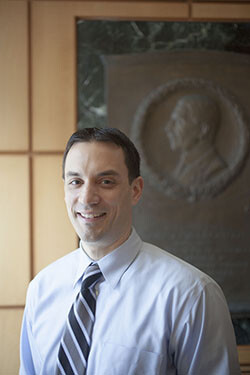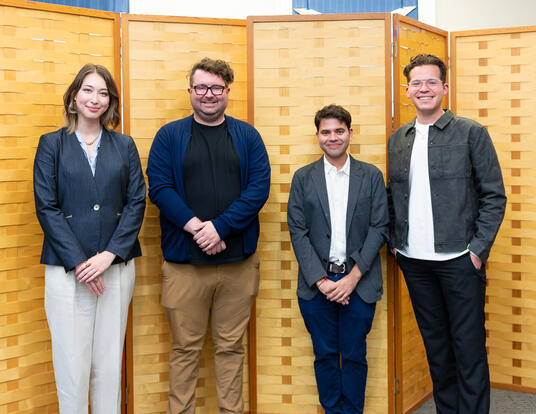What’s the Alternative?
How recent PhDs are reaching beyond the academy

In 1900, when Harvard’s twenty-first president, Charles William Eliot, met with the presidents of the University of California, the University of Chicago, Columbia University, and the Johns Hopkins University, American doctoral education was still a protean concept. Eliot had founded Harvard’s Graduate Department in 1872; the University conferred its first PhD in 1873. But graduate training across the United States was remarkably uneven, particularly in contrast to the gold standard of German research universities. Eliot and his colleagues were about to change that.
Soon after, Harvard’s Graduate School was renamed the Graduate School of Arts and Sciences as part of Eliot’s efforts to transform Harvard into a modern research university. For Eliot, increasing the rigor of graduate training, including a research-based dissertation, would strengthen the professoriate, which in turn would improve undergraduate teaching, at Harvard, and across the nation. This is where the modern conception of a graduate school, and the notion that a doctorate equals research and teaching, starts.
As a result, the number of doctoral degrees awarded in the US nearly doubled every decade from 1870 to 1970. In the 1960s, in the wake of Sputnik, degrees almost tripled, peaking in the early 1970s and again in the late 1990s. Given the institution-building focus of 20th-century graduate education, it’s not surprising that the path after the PhD seems predictable.
What are the alternatives? Well, as it turns out, there are many.
Beyond the Academy
By the early 1990s, American PhDs had started branching out beyond the academy. About half took positions in higher education, with the balance headed into industry, secondary education, government, and nonprofits. These proportions have remained largely consistent over the last 20 years.
Even still, not too long ago the term “alt-ac,” shorthand for “alternative academic,” was embraced enthusiastically by humanities PhDs, particularly those working in the burgeoning field of digital humanities.
“‘Alt-ac’ caught on as a simpler way of describing complex career trajectories of many PhDs going into higher education in one way or another, but not taking traditional paths into tenure-
track academic positions,” explains William Pannapacker, PhD ’99, history of American civilization, and professor of English at Hope College in Michigan.
Pannapacker, known for his frank accounts of the realities of the humanities job market published in The Chronicle of Higher Education, admits wryly that he’s shifted from “being a provocateur” toward “different ways of thinking about graduate and undergraduate education.” In 2009, he founded, and now directs, Hope’s Andrew W. Mellon Foundation Scholars Program in the Arts and Humanities. The program focuses on “rebooting” the liberal arts by integrating traditional liberal arts methods with digital, experiential education and collaborative research. He also directs the Great Lakes College Association’s Digital Liberal Arts Initiative, helping faculty in nonquantitative fields across the 13-college association integrate digital approaches in their teaching and research, as well as fostering student-faculty research collaborations. Pannapacker’s own trajectory exemplifies his broader view that career paths after the PhD can be “serendipitous,” shaped as much as by a scholar’s own temperament as by larger economic and social forces.
Idea-driven Work
So what is—or is not—different about being a PhD outside the academy?
“Museum work is not an alternative to academic work, it’s just another form of academic work,” is the way Sarah Anne Carter, PhD ’10, history of American civilization, answers that question. Carter spoke last fall on an alumni panel convened by the Program in American Studies about interdisciplinary career paths.
Carter’s work at Harvard bridged the academy and the museum. Alongside one of her thesis advisors, historian and 300th Anniversary University Professor Laurel Thatcher Ulrich, she co-taught the popular general education course, “Tangible Things: Harvard Collections in World History.” Carter also served as the project manager of the multi-site Harvard museum exhibition of the same name, and co-authored the related book, Tangible Things: Making History through Objects (2015) with Ulrich, Ivan Gaskell, and Sara Schechner, PhD ’88, history of science. Carter’s dissertation, Object Lessons in American Culture, explores the 19th-century practice of teaching abstract concepts and ideas through the study of objects. It will soon be published as a book by Oxford University Press.
Carter started out applying for traditional academic jobs. Her path to the Chipstone Foundation in Milwaukee, a museum focused on material culture and the decorative arts, where she is now curator and director of research, was, well, serendipitous, and the product of a strong professional network. It was a natural fit, one that has allowed her to keep one foot in the academy, teaching in the art history department at the University of Wisconsin–Madison.
Parsing the line between what’s “alternative” and what’s “academic” may obscure more than it illuminates. Says Carter, “The folks I work with are all driven by ideas and they’re driven by questions. And if you find communities like that, it’s really not that different from being in a university community.”
The nomenclature distinguishes where a PhD works—inside, outside, or adjacent to the academy—but not how doctoral training prepares students to tackle complex problems in any field. What’s alternative about using high-level analytical skills, both qualitative and quantitative, in an idea-driven world? The distinction is increasingly obsolete. As David Cardozo, director of graduate studies and associate dean for graduate studies in the Division of Medical Sciences (DMS), puts it “the word alternative doesn’t even come up anymore” when students are considering where to land after the PhD.
New Possibilities
In that sense, the vision Eliot and his colleagues had of rigorous graduate training as the foundation for advancing original research in the US has come to fruition. At the same time, the opportunities for PhDs to put their training to work outside the academy are expanding, in part due to broader changes in how knowledge is generated, shared, and applied across the disciplines. Many fields—particularly the sciences—depend on close collaborations between the academy and industry, demonstrating the tremendous potential of increasingly porous boundaries between the two.

We want Harvard-trained PhDs to be working in many fields—to be advising the government on policy or to be serving on the boards of companies. That’s good for society. – Allen Aloise
According to Allen Aloise, PhD ’04, chemistry, director of graduate studies for FAS science and director of laboratories in the Department of Chemistry and Chemical Biology, “over the last twenty years the sciences have been transformed by investments from the National Institutes of Health, so that many different disciplines within science have shifted their focus to biology. In industry, corporations have consolidated, but many small start-ups have arisen as well. This presents students with new opportunities beyond traditional faculty or corporate paths, leading to more science PhDs working in law, medicine, communications, biotech, start-ups, policy, and consulting.”
Laura Stark, director of career advising and programming for master’s and PhD students in the FAS Office of Career Services (OCS), agrees. A neurobiologist herself, Stark attributes the changing way PhDs consider their career opportunities to “the big data explosion, which is reshaping careers in the sciences.” But it’s not just the sciences that are changing, says Stark. “Data science has also opened up new possibilities in cultural institutions, corporations, and nonprofits for PhDs in the humanities and the social sciences with exceptional analytical skills.”
Stark, who advises graduate students, partners with GSAS departments on discipline-specific career advising, and designs OCS programs for graduate students, sees these wider changes reflected in how students think about their careers: “students assume that they are going to be exploring a variety of careers in pursuit of the best fit and the best way to contribute to the world.”
Finding the Right Fit
That’s what Knatokie Ford, PhD ’11, biological and biomedical sciences, did. She sought out advice from mentors and career advisors, whose insights helped her figure out how to best “use my scientific training to advance science and serve society.” Ford’s path, following a postdoc at Boston’s Beth Israel Deaconess Medical Center, led to a fellowship from the American Association for the Advancement of Science in science and technology policy. Her experience as a staffer for the President’s Council of Advisors on Science and Technology in the White House Office of Science and Technology Policy inspired her to think equally boldly to leverage her policy experience into STEM consulting focused on “using media to bring a different face to science, train scientists, and change the way science is presented.”
GSAS students often tap into the resources of the University in creative ways. For example, neurobiologist Carlos Loya, PhD ’11, biomedical and medical sciences, was curious about “how we take ideas and put them into the clinic or the market.” That question landed him in what was then a new course at Harvard Business School, “Commercializing Science,” taught by Vicki L. Sato, PhD ’72, biology, professor of the practice in the Department of Molecular and Cell Biology and professor of management practice at HBS.
Loya was on a team with PhDs and MBAs that created a business plan based on cutting-edge cancer genetics research from the Dana Farber Cancer Institute labs of Lynda Chin and Ronald A. DePinho. Loya’s team decided to take their business plan on the road and pitch it to local venture capital firms, “as an academic exercise and to improve the project.” For Loya it was a “formative and transformational experience,” leading to two internships, first at Siemens Venture Capital, and later, after he finished his dissertation, at Third Rock Ventures. While at Third Rock Ventures, he helped incubate Sage Therapeutics, and after the new company launched, Loya worked on the science and management side, helping develop new treatments for central nervous system diseases.
He calls his current position, managing corporate development projects for biopharmaceutical and biotech companies for the consulting firm Campbell Alliance, his “third postdoc” because it reflects the same spirit of learning by doing that happens in a traditional postdoc. Loya traces everything back to the PhD. “You have to love the science and succeed at it. Then figure out what you’re passionate about, and that will help you figure out your next step.”
Supporting Student Initiatives
In many cases, supporting students’ explorations means putting the institutional stamp on their initiatives, or making students aware of the many GSAS programs that help them connect their intellectual interests with professional opportunities. “We’ve quickly learned that the best ideas come from students and the key to success is providing the support and freedom for them to unleash their creativity and enthusiasm,” explains Cardozo. Since 2008, the Paths Program at DMS has done just that by supporting student-directed initiatives and clubs, with resources from OCS and faculty advisors to help students investigate career paths in biotechnology, consulting, law, education, policy and nonprofits, and science writing.
Mentoring plays a key role in helping students understand their options, and faculty advisors are just one avenue for advice. “Our alumni have been extraordinary about giving back and mentoring our current students,” Cardozo said. Students at DMS also have the option of taking for-credit courses, such as “Drug Development from Concept to Commercialization,” which uses the HBS case-study method to trace how a successful drug goes from the lab to the market, and the other, on health care consulting innovation, which provides students with a “business toolkit” in life sciences entrepreneurship. As director of graduate studies, Cardozo is setting his sights on further development of elective curricula for the Paths Program with hopes for greater cross-school collaboration that will strengthen students’ professional preparation as they work toward their degrees.
Across GSAS, students have access to a wide range of institutional opportunities and student-run programs that help them identify the right fit. The Harvard Integrated Life Sciences Program, for example, allows GSAS science students to work with advisors and in labs in the Division of Medical Sciences and at Harvard Medical School. Having the option to pursue a secondary field as part of their coursework can help doctoral candidates in all the disciplines enhance the professional reach of their disciplinary expertise. The Harvard Interdisciplinary Graduate Consortia enables students to investigate topics such as human rights, global health, and climate change through multidisciplinary seminars and reading groups. And many GSAS student organizations sponsor speaker series, publish journals, and provide valuable pre-professional experience organizing conferences and events.
Training Leaders
An individualized approach to advising and mentorship is also essential to helping students find their post-PhD path. “We want to attract and recruit the best, most promising graduate students in the world, and when they are here, we want them to achieve their highest potential. Then, we want to give them all the tools necessary to embark on and succeed in the career of their choosing,” says Aloise. “We want Harvard-trained PhDs to be working in many fields—to be advising the government on policy or to be serving on the boards of companies. That’s good for society.”
Illustration credit: Jonathan Calugi
Get the Latest Updates
Join Our Newsletter
Subscribe to Colloquy Podcast
Simplecast





